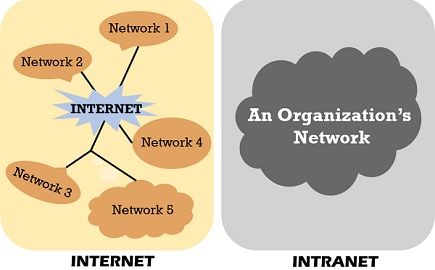
The internet and the intranet are both computer networks, but they differ in their scope, accessibility, and purpose. Here’s an overview of the differences between the two:
- Scope and Accessibility:
- Internet: The internet is a global network of interconnected devices and networks that spans the entire world. It allows millions of computers, servers, and other devices to communicate with each other. The internet is publicly accessible, meaning anyone with an internet connection can access its resources and services.
- Intranet: An intranet is a private network that is restricted to a specific organization, such as a company, school, or government agency. It is designed for internal use only and is not accessible to the general public. Access to an intranet is typically limited to employees or authorized users within the organization.
- Connectivity:
- Internet: The internet connects various networks worldwide using a standard set of protocols known as the Internet Protocol Suite (TCP/IP). It enables communication and data transfer between different devices and networks regardless of their geographical location.
- Intranet: An intranet is a localized network that is often built upon the same technologies and protocols as the internet but is privately owned and maintained by an organization. It may be connected to the internet but usually has additional security measures in place to protect internal resources and sensitive information.
- Purpose and Functionality:
- Internet: The internet provides a vast array of services, resources, and information to users around the world. It facilitates activities such as email, web browsing, file sharing, online shopping, social networking, and much more. It serves as a global platform for communication, collaboration, and access to information on a wide scale.
- Intranet: An intranet is primarily used to facilitate internal communication, collaboration, and information sharing within an organization. It typically hosts internal websites, databases, document repositories, and other resources that are relevant to the organization’s operations. Intranets often provide tools for employee communication, project management, document sharing, and internal announcements.
- Security:
- Internet: Due to its global nature and public accessibility, the internet poses security challenges. Users must take precautions such as using secure connections (e.g., HTTPS), employing firewalls, and utilizing security software to protect their devices and data from unauthorized access or malicious activities.
- Intranet: Intranets are designed with a greater emphasis on security since they are meant for internal use only. Organizations can implement various security measures, such as firewalls, access controls, encryption, and authentication mechanisms, to safeguard their intranet resources and ensure that sensitive information remains protected from external threats.
In summary, the internet is a worldwide network that allows global communication and access to a wide range of resources, while an intranet is a private network restricted to an organization, serving internal communication and information sharing purposes.
Share your own answer and let others learn from you. Shoplife





